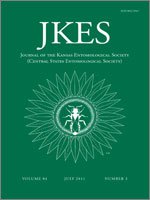The small stingless bee, Tetragonula fuscobalteata (Cameron), is widely distributed in Southeast Asia and is used in Thailand to supply honey and to enhance pollination of tropical fruits. A method of establishing colonies in hives without inbreeding is presented. Clusters of cocoons consisting of both workers and males are transferred to a new box, and a queen from another source colony is provided. Mating occurs in the box. Cocoons of workers and males are distinguishable by shape, and can therefore be transferred in the proportions desired. Details of provisioning of brood cells and of oviposition are presented; the egg laying involved one contraction of the queen's abdomen for a male-producing cell, two contractions for a worker cell. The duration of development (egg laying to adult) decreases with rise in temperature; 35 C or higher is destructive.
How to translate text using browser tools
1 July 2011
Aspects of Culturing, Reproductive Behavior, and Colony Formation in the Stingless Bee Tetragonula fuscobalteata (Hymenoptera: Apidae: Meliponini)
Somnuk Boongird
ACCESS THE FULL ARTICLE





